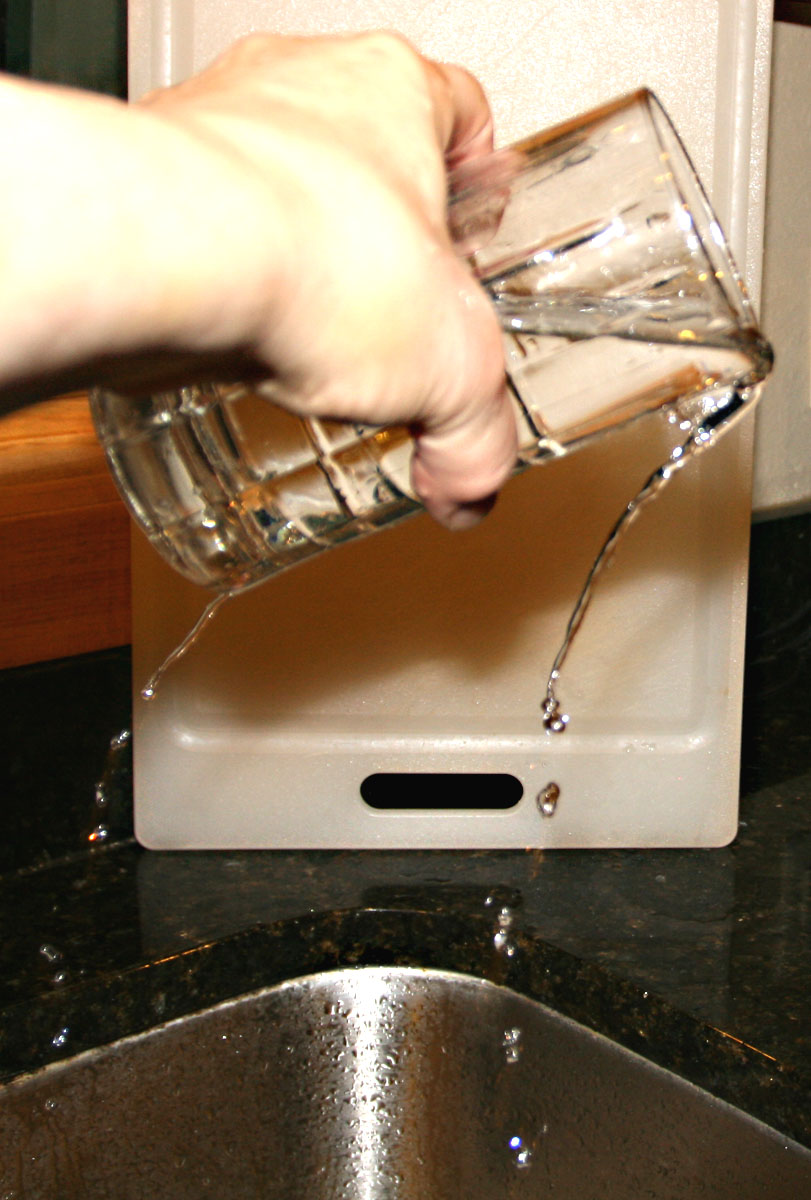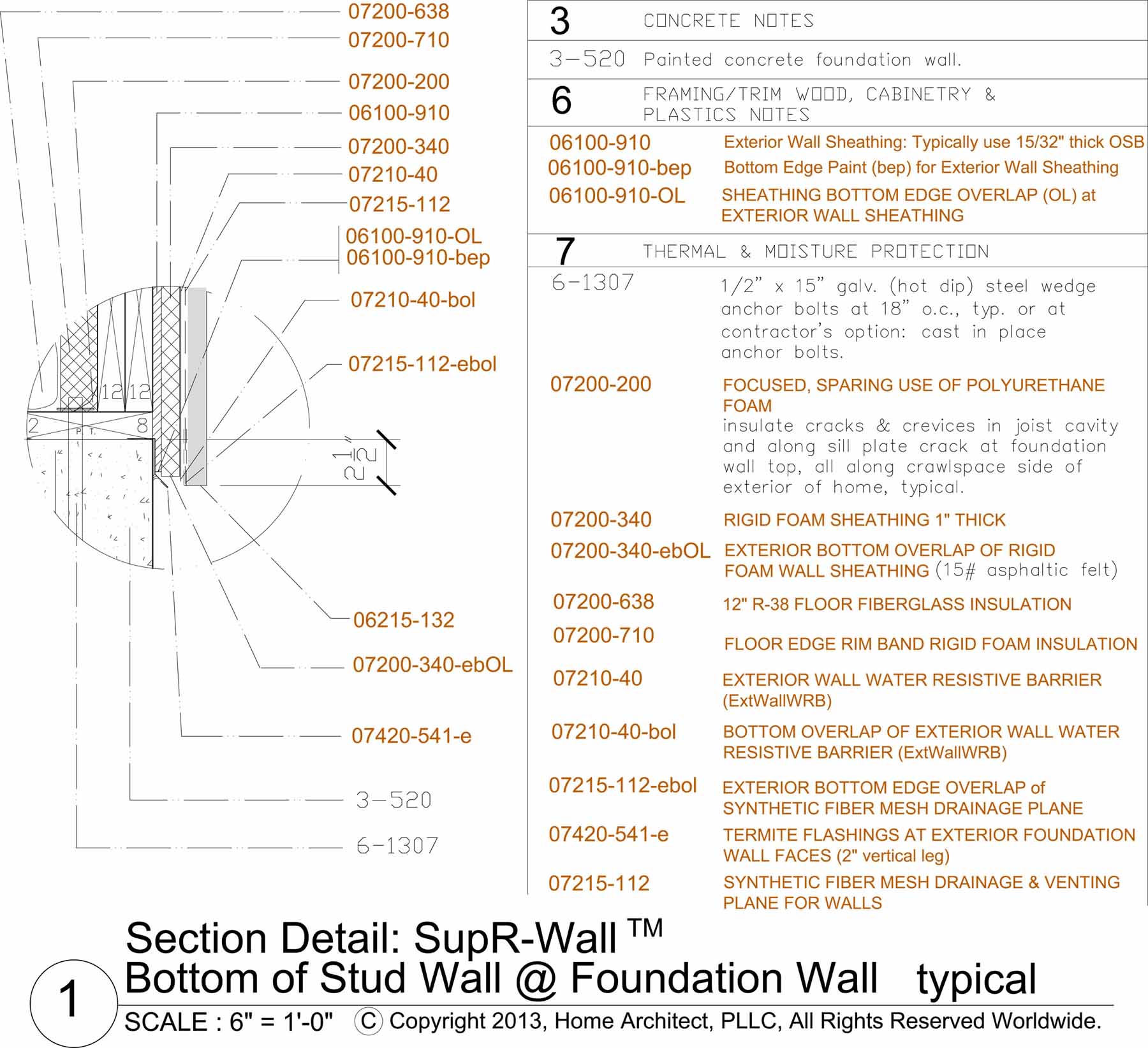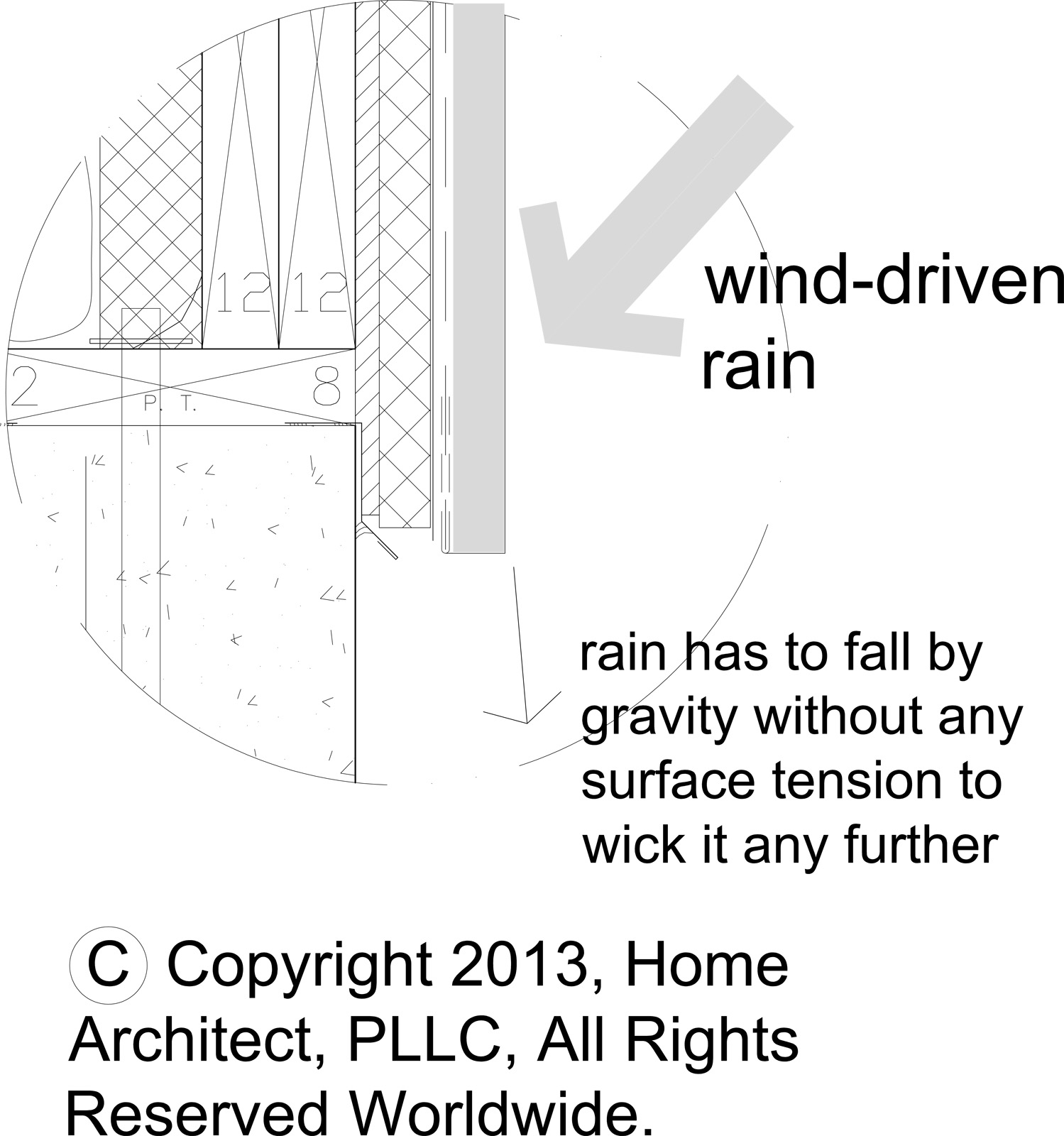
An Architect invented that phrase: Ludwig Mies Van der Rohe. And he was correct: buildings and houses live and die by good or bad details. Rand Soellner, Senior Staff Architect of the architectural firm: HOME ARCHITECTS ® agrees that good detailing is essential to durable, properly functioning houses.
Case in point: the bottom edge of stud frame walls where they meet the top of the foundation wall. There’s a lot going on here and your Architect really needs to think carefully about this area and orient all the pieces and parts so that insects and other pests cannot invade or eat the house, so that rain cannot enter the wall and rot the house or cause mold to grow (which will make you deathly ill & rot your house) and so that you will have a good, clean and tight energy-efficient place to live. How can all that be happening just at the bottom of the main house walls? Read on to find out…
This bottom portion of a stud wall is part of this architectural company’s new “SupR-Wall ™ “. Which has an R-27+, unmatched by any other stud wall arrangement using fiberglass batt insulation in the World. Click here for more information about the –> SupR-wall .
God is in the details :
This wall is essentially an ordinary2x6 wood stud wall with 6″ thick R-19 fiberglass batt insulation. However, there are several noticeable tweaks:
1. 15/32″ OSB (Oriented Strand Board) is used as continuous structural wall sheathing and bracing over the entire exterior face of the wall. In the specs, it is called to be both glued and ringshank nailed to the studs as a Shear Wall, which will not only make the wall stronger, but keep out pests, due to the seal between the glue, the sheathing and the studs.
2. 1″ thick rigid insulation covers the entire exterior of the structural sheathing, provide “ci” (Continuous Insulation) over the entire wall, effectively erasing the thermal shunts caused by each stud in the wall. This provides another R-5 of continuous insulation wrapping the entire wall surface, enhancing the wall’s ability to resist heat transfer.
3. #15 pound Asphaltic Felt is used on the exterior of the rigid foam sheathing, working as a combination Exterior Wall Water Resistive Barrier (ExtWallWRB), “Smart” Vapor Barrier, and Air Barrier. All of the joints are taped with a special asphaltic modified tape engineered by a major construction product manufacturer to bond to surfaces like asphaltic felt. It is this taping that allows the felt to function as an Air Barrier. Exterior wind pressure cannot breach the joints if they are taped. Also, this “intelligent” water barrier keeps out liquid water, but allows the wall to breath when you want it to, as tested by the University of Massachusetts and the Building Science Corporation.
4. A drainage plane nylon fibermesh fabric 1/4″ thick is placed over the face of the ExtWallWRB. This drainage plane breaks the hydrostatic pressure of any water that may have breached the exterior cladding, removing the pressure that could have otherwise driven the moisture into the core of the wall. With this 1/4″ gap, any water will now drain into the drainage plane fibermesh and down and out the bottom. The ExtWallWRB is barely touched with any moisture and that means that it can do its job much better than before.
Also, the drainage plane is detailed not only to drain along the bottom (with insect screen to keep out pests), but is also vented along the top (also with insect screen), to allow any moisture and heat in this drainage plane gap to vent out, allowing the ExtWallWRB to remain dry and doing its job. (Click here for more information on Healthy house design: –>here.) Drainage planes are a code requirement in Canada. It is only a question of time before America wakes up and starts doing this (like this article’s architectural firm is).
5. Exterior wall cladding: siding, brick, stone, or whatever you want.
That is the composition of the SupR-Wall ™.

Now let’s take a look at the bottom of this Super Wall. Well, why does the Architect need to be concerned with how the Contractor might stop all of the above elements in this type of wall? Well, how about SURFACE TENSION of water? That’s the tendency of water, when pouring over a surface, to cling to it and when tipped even horizontal, water can even run horizontally, back toward the building,
rotting parts of the building, saturating wooden elements (and masonry and concrete surface for that matter) and putting water in a path where it can be siphoned (wicked) up into wooden materials by CAPILLARY ACTION. The designer of your house should be aware of these characteristics of moving water. Most Architects are.
Okay, so what’s this got to do with the bottom of your stud walls in your next house? Well, for one thing, you really do NOT want ALL of your wall materials stopping at exactly the same level, which would create a horizontal surface across which water could bridge and flow, through surface tension, back toward your house, causing rot, mold and other negative situations. So what should be done with all of the parts of your stud wall? The simple and obvious answer, once you understand about the nature of water and surface tension is: OFFSET EACH LAYER LOWER THAN THE PREVIOUS INBOARD LAYER.
Take a good look at this architectural firm‘s detail. Look very closely. It DOES overlap each next layer of wall material lower than the previous one, making it just about impossible for rain, flowing down the outer surface of the exterior of the wall finish to turn back horizontally and flow toward the house. Each succeeding layer forms an unavoidable drip edge, thwarting water’s tendency to try to get into your house. AND IT TAKES A LICENSED ARCHITECT TO BUILD THESE SORTS OF DETAILS INTO YOUR HOUSE.
(Click here for more reasons why an Architect should design your house: –>Here.)
This isn’t the way most builders do it or other people involved with the design or construction of houses. It takes a great deal of focused experience, thinking deeply about how things work, to invent excellent solutions like this. Simple, once you know what to do, but dire results await those who haven’t had the knowledge and experience to know what to do.
And let’s look at the detail of the HOME ARCHITECTS ® even more closely. They are calling for the edge of the wooden structural sheathing (OSB) to have the bottom edge painted with latex paint BEFORE being installed (trust us, it says so in the specifications to which all those numbered notes refer). Why? SO that all of the holes and slots that exist in the edge of the wooden sheathing, not to mention the raw wood surface itself, is NOT exposed to the environment. The paint seals the edge and prevent any moisture absorption, making the wood last decades longer. And bugs won’t find painted wood half as appealing as rough cut, exposed wood (that will also have all sorts of gaps and slots for them to inhabit). This author actually tested painted wood underground for 18 years in Central Florida, on otherwise untreated wood and found that painted wood Can resist both water rot and termites, although this is not recommended for ground contact wood; just illustrating that paint Can have be very effective protecting raw wood from moisture and insects. Click here for more information about–> Green Home Architects.
And look; there is TERMITE FLASHING. Did you know that minimum Code doesn’t even require this? Only prudent professionals (Architects) provide this sort of requirement like breathing. Click here for more information about what Minimum Code Does Not do: –> minimum code and life safety.
And there is INSECT SCREENING folded around the bottom of the DRAINAGE PLANE to keep pests out of your walls, while allowing them to drain and be dry. Sensible and obvious, once you think about it. And that’s one of the reasons you hire an Architect: to think about these sorts of things for you.
Contact this Architect to start designing your next house: Rand@HomeArchitects.com 828-269-9046.
tags: god is in the details, cashiers, newnan, hendersonville, atlanta, asheville, revit architect, aspen, telluride, post and beam, timber frame, custom


